Abstract
OBJECTIVE: Despite generalized intervention programs, restraint use among African Americans remains below national levels, especially among children. This study describes the development and implementation of a community participatory faith-based youth injury prevention program. METHODS: Through a partnership with the African-American faith-based community and our injury prevention group, a unique multigenerational intervention program was developed targeting motor vehicle restraint use. Once developed, the program was initially evaluated by comparing outcomes between control and intervention churches. The main objective was to observe adult and pediatric restraint use before and after program implementation. RESULTS: Overall, there was excellent recognition and participation in the program. Following program implementation, significant improvements were observed in restraint use compared to control churches. In particular, there was a 72% reduction in unrestrained children, a 25% increase in children being secured in the rear-seat position and a nearly 20% increase in driver restraint use. CONCLUSIONS: The development and implementation of a culturally sensitive intervention program can significantly improve restraint use in a minority population. Partnering with the community in all phases of the program is essential to its success.
Full text
PDF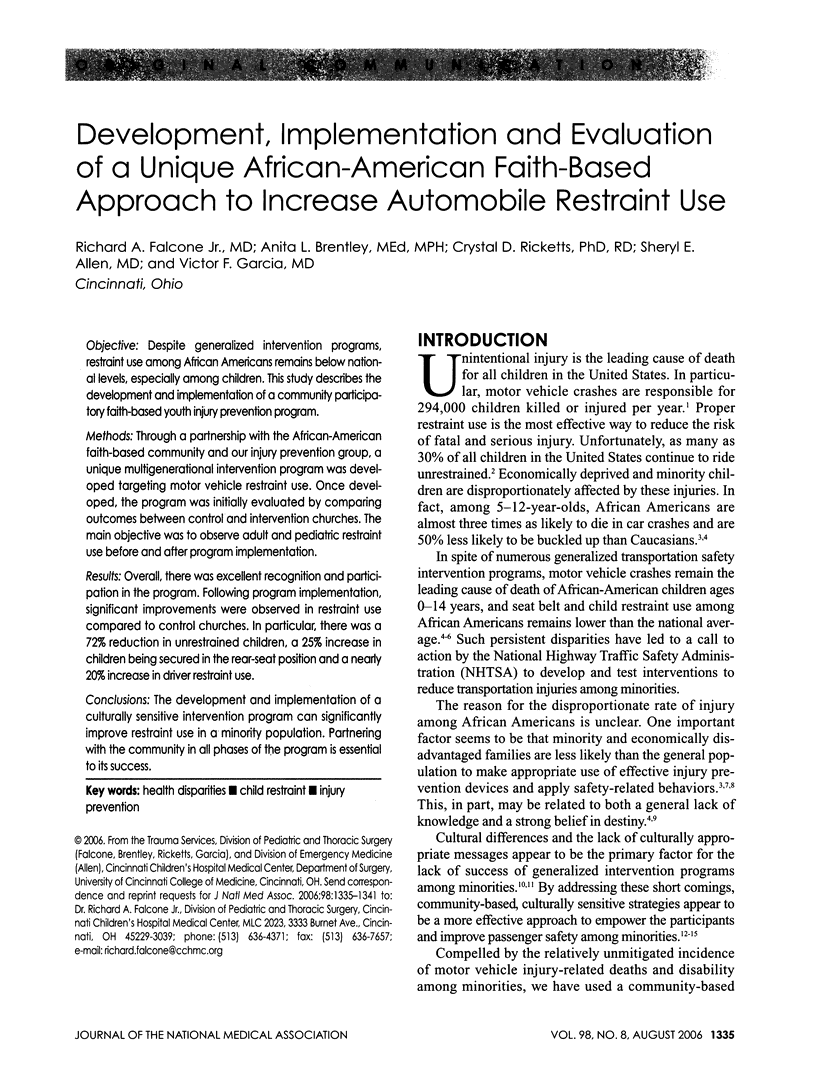
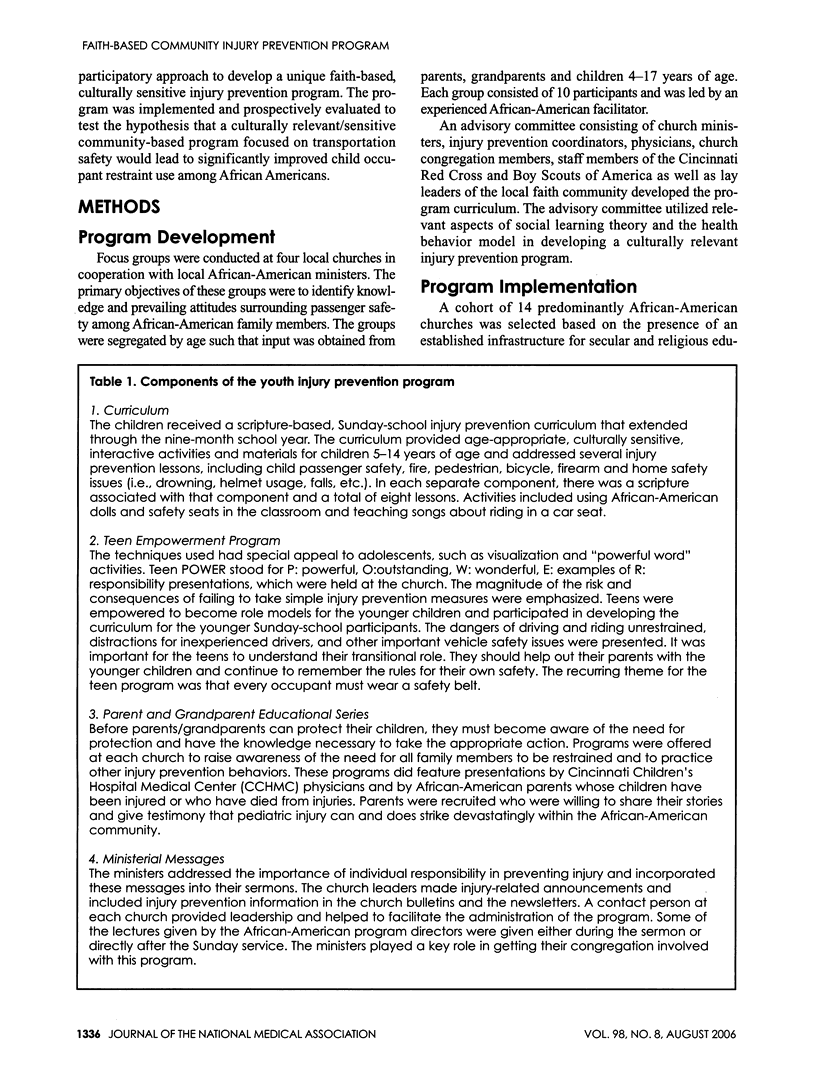
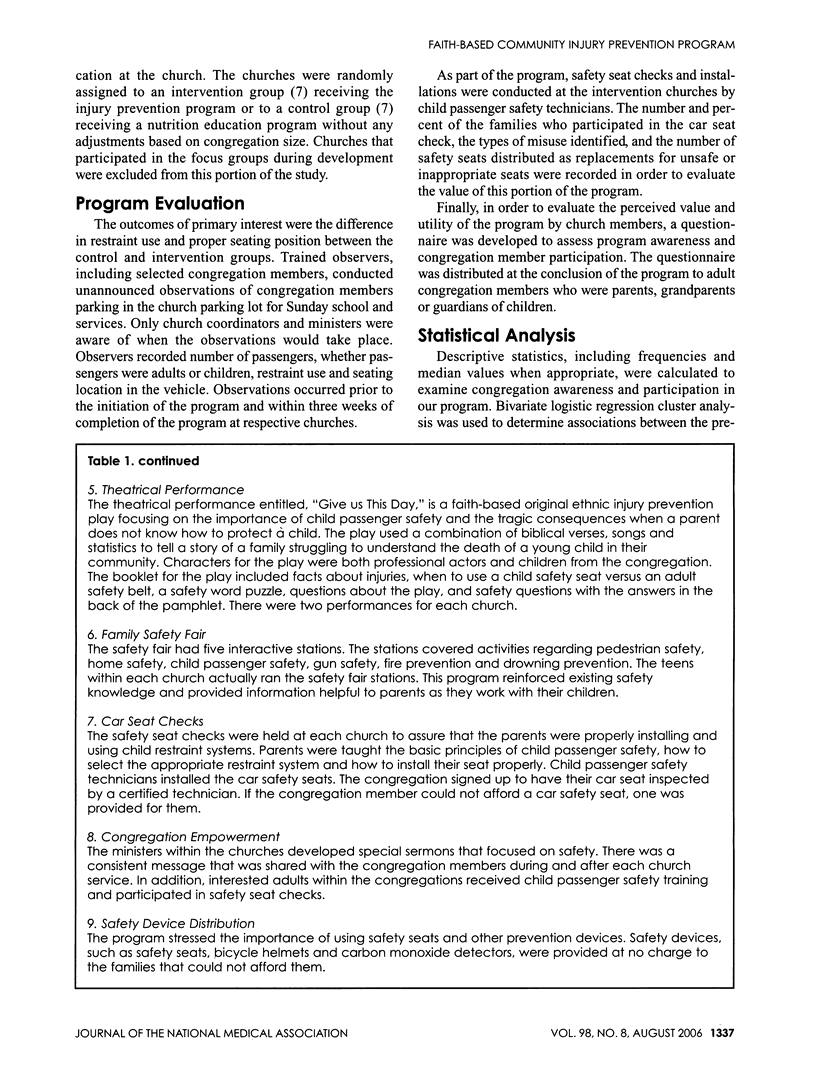
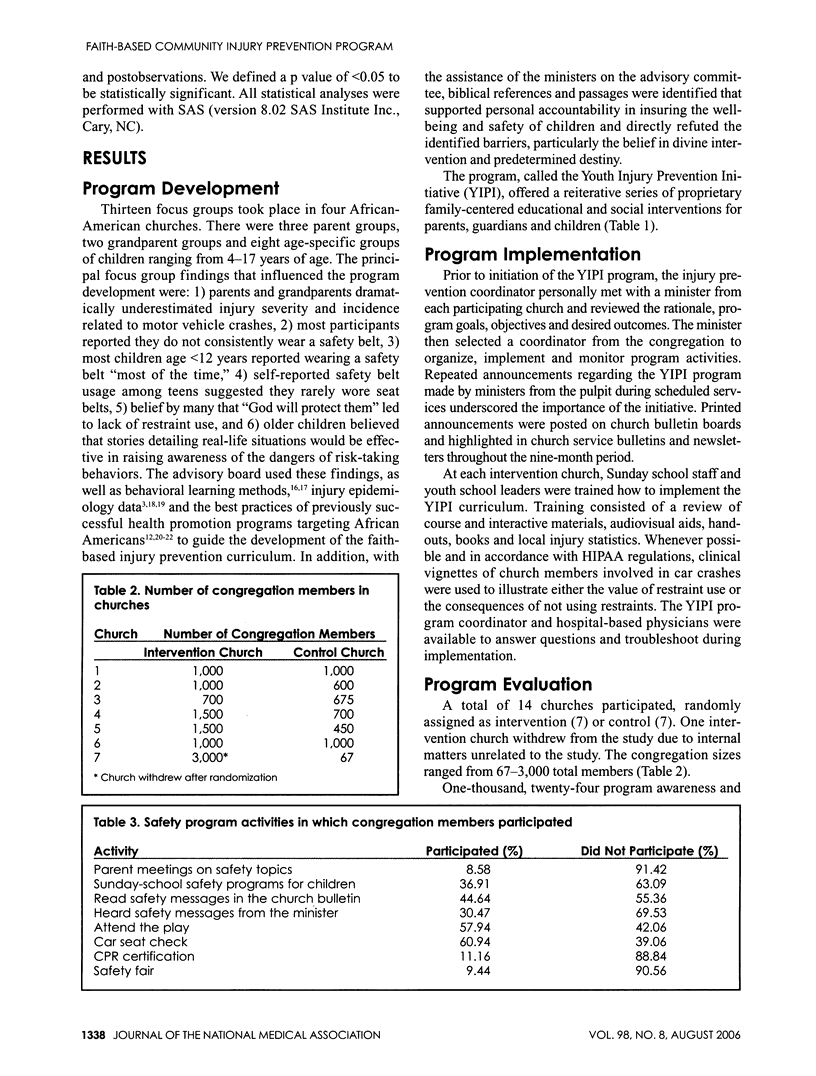
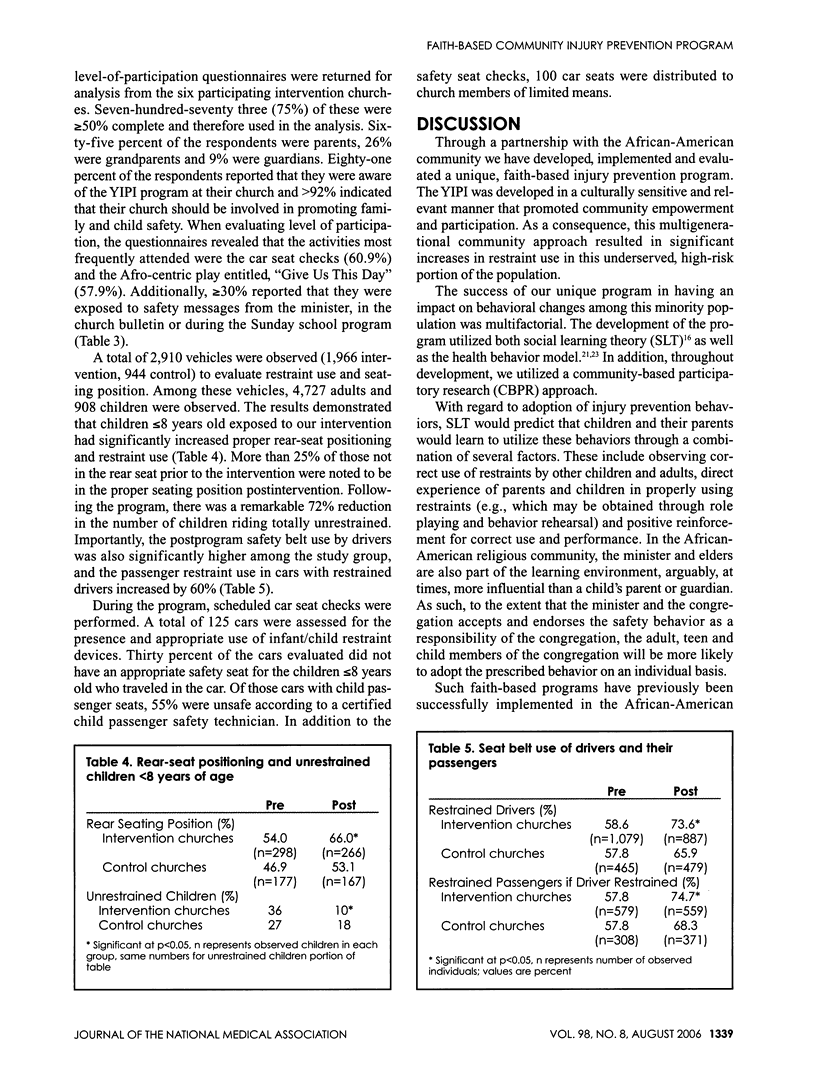
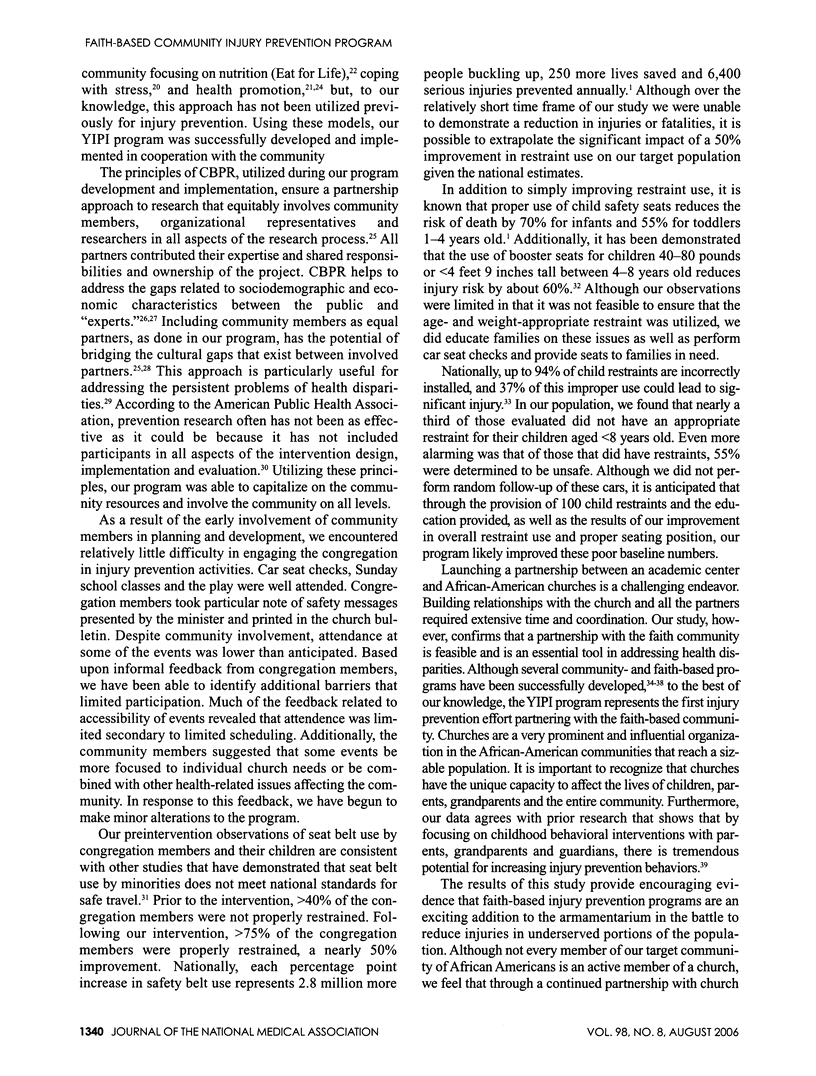
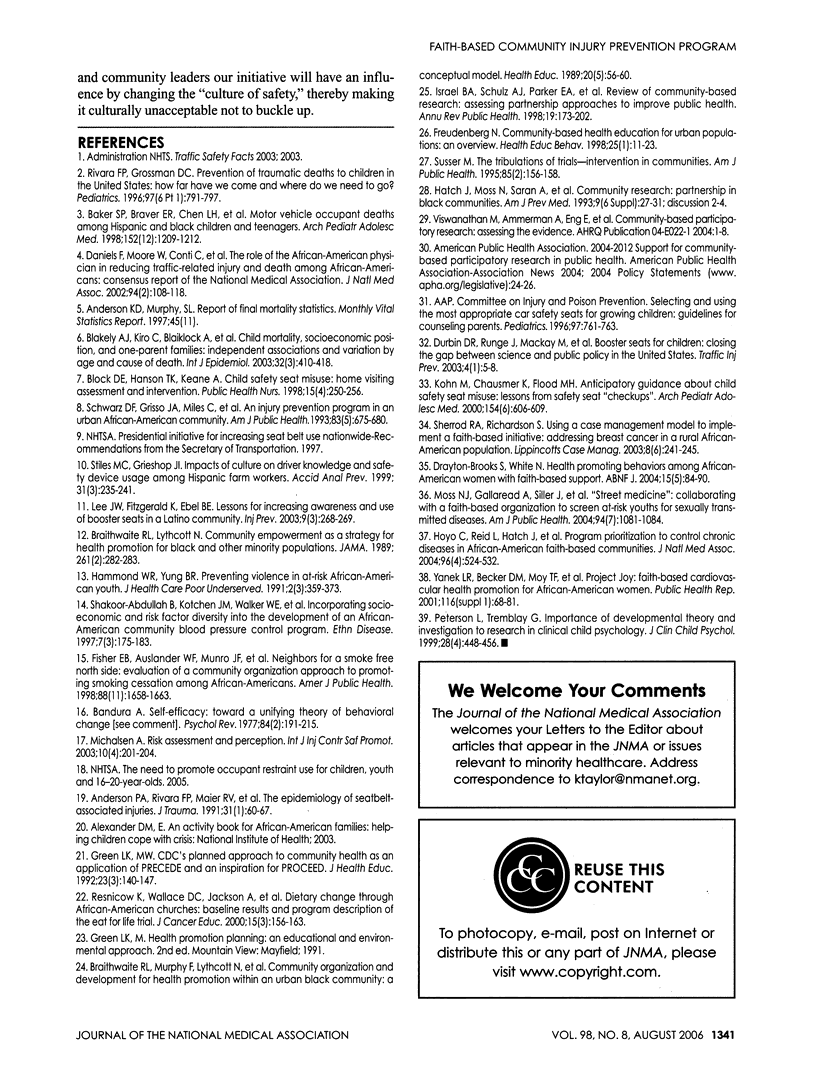
Selected References
These references are in PubMed. This may not be the complete list of references from this article.
- Anderson P. A., Rivara F. P., Maier R. V., Drake C. The epidemiology of seatbelt-associated injuries. J Trauma. 1991 Jan;31(1):60–67. doi: 10.1097/00005373-199101000-00012. [DOI] [PubMed] [Google Scholar]
- Baker S. P., Braver E. R., Chen L. H., Pantula J. F., Massie D. Motor vehicle occupant deaths among Hispanic and black children and teenagers. Arch Pediatr Adolesc Med. 1998 Dec;152(12):1209–1212. doi: 10.1001/archpedi.152.12.1209. [DOI] [PubMed] [Google Scholar]
- Bandura A. Self-efficacy: toward a unifying theory of behavioral change. Psychol Rev. 1977 Mar;84(2):191–215. doi: 10.1037//0033-295x.84.2.191. [DOI] [PubMed] [Google Scholar]
- Blakely Tony, Atkinson June, Kiro Cindy, Blaiklock Alison, D'Souza Amanda. Child mortality, socioeconomic position, and one-parent families: independent associations and variation by age and cause of death. Int J Epidemiol. 2003 Jun;32(3):410–418. doi: 10.1093/ije/dyg154. [DOI] [PubMed] [Google Scholar]
- Block D. E., Hanson T. K., Keane A. Child safety seat misuse: home visiting assessment and intervention. Public Health Nurs. 1998 Aug;15(4):250–256. doi: 10.1111/j.1525-1446.1998.tb00347.x. [DOI] [PubMed] [Google Scholar]
- Braithwaite R. L., Lythcott N. Community empowerment as a strategy for health promotion for black and other minority populations. JAMA. 1989 Jan 13;261(2):282–283. [PubMed] [Google Scholar]
- Daniels Fernando, Moore Wayne, Conti Christopher, Norville Perez Lucille C., Gaines Beverly M., Hood Rodney G., Swain Ian J. J., Williams Rudolph, Burgess Chaka T. The role of the African-American physician in reducing traffic-related injury and death among African Americans: consensus report of the National Medical Association. J Natl Med Assoc. 2002 Feb;94(2):108–118. [PMC free article] [PubMed] [Google Scholar]
- Drayton-Brooks Shirlee, White Neva. Health promoting behaviors among African American women with faith-based support. ABNF J. 2004 Sep-Oct;15(5):84–90. [PubMed] [Google Scholar]
- Durbin Dennis R., Runge Jeffrey, Mackay Murray, Meissner Uwe, Pedder Jocelyn, Wodzin Elaine, Yoganandan Narayan. Booster seats for children: closing the gap between science and public policy in the United States. Traffic Inj Prev. 2003 Mar;4(1):5–8. doi: 10.1080/15389580309850. [DOI] [PubMed] [Google Scholar]
- Fisher E. B., Auslander W. F., Munro J. F., Arfken C. L., Brownson R. C., Owens N. W. Neighbors for a smoke free north side: evaluation of a community organization approach to promoting smoking cessation among African Americans. Am J Public Health. 1998 Nov;88(11):1658–1663. doi: 10.2105/ajph.88.11.1658. [DOI] [PMC free article] [PubMed] [Google Scholar]
- Hammond W. R., Yung B. R. Preventing violence in at-risk African-American youth. J Health Care Poor Underserved. 1991 Winter;2(3):359–373. doi: 10.1353/hpu.2010.0341. [DOI] [PubMed] [Google Scholar]
- Hawks S. R. Exercise and weight loss: the uncertain connection. Health Educ. 1989 Aug-Sep;20(4):11–15. [PubMed] [Google Scholar]
- Hoyo Cathrine, Reid Laverne, Hatch John, Sellers Denethia B., Ellison Arlinda, Hackney Tara, Porterfield Deborah, Page Joyce, Parrish Theodore. Program prioritization to control chronic diseases in African-American faith-based communities. J Natl Med Assoc. 2004 Apr;96(4):524–532. [PMC free article] [PubMed] [Google Scholar]
- Kohn M., Chausmer K., Flood M. H. Anticipatory guidance about child safety seat misuse: lessons from safety seat "checkups". Arch Pediatr Adolesc Med. 2000 Jun;154(6):606–609. doi: 10.1001/archpedi.154.6.606. [DOI] [PubMed] [Google Scholar]
- Lee J. W., Fitzgerald K., Ebel B. E. Lessons for increasing awareness and use of booster seats in a Latino community. Inj Prev. 2003 Sep;9(3):268–269. doi: 10.1136/ip.9.3.268. [DOI] [PMC free article] [PubMed] [Google Scholar]
- Michalsen Andrej. Risk assessment and perception. Inj Control Saf Promot. 2003 Dec;10(4):201–204. doi: 10.1076/icsp.10.4.201.16782. [DOI] [PubMed] [Google Scholar]
- Moss Nicholas J., Gallaread Alonzo, Siller Jacqueline, Klausner Jeffrey D. "Street medicine": Collaborating with a faith-based organization to screen at-risk youths for sexually transmitted diseases. Am J Public Health. 2004 Jul;94(7):1081–1084. doi: 10.2105/ajph.94.7.1081. [DOI] [PMC free article] [PubMed] [Google Scholar]
- Peterson L., Tremblay G. Importance of developmental theory and investigation to research in clinical child psychology. J Clin Child Psychol. 1999 Dec;28(4):448–456. doi: 10.1207/S15374424JCCP2804_3. [DOI] [PubMed] [Google Scholar]
- Resnicow K., Wallace D. C., Jackson A., Digirolamo A., Odom E., Wang T., Dudley W. N., Davis M., Mitchell D., Baranowski T. Dietary change through African American churches: baseline results and program description of the eat for life trial. J Cancer Educ. 2000 Fall;15(3):156–163. doi: 10.1080/08858190009528685. [DOI] [PubMed] [Google Scholar]
- Rivara F. P., Grossman D. C. Prevention of traumatic deaths to children in the United States: how far have we come and where do we need to go? Pediatrics. 1996 Jun;97(6 Pt 1):791–797. [PubMed] [Google Scholar]
- Schwarz D. F., Grisso J. A., Miles C., Holmes J. H., Sutton R. L. An injury prevention program in an urban African-American community. Am J Public Health. 1993 May;83(5):675–680. doi: 10.2105/ajph.83.5.675. [DOI] [PMC free article] [PubMed] [Google Scholar]
- Sherrod Roy Ann, Richardson Sandra. Using a case management model to implement a faith-based initiative: addressing breast cancer in a rural African American population. Lippincotts Case Manag. 2003 Nov-Dec;8(6):241–245. doi: 10.1097/00129234-200311000-00005. [DOI] [PubMed] [Google Scholar]
- Stiles M. C., Grieshop J. I. Impacts of culture on driver knowledge and safety device usage among Hispanic farm workers. Accid Anal Prev. 1999 May;31(3):235–241. doi: 10.1016/s0001-4575(98)00072-4. [DOI] [PubMed] [Google Scholar]
- Swedish National Committee for Public Health Health on equal terms--national goals for public health. Scand J Public Health Suppl. 2001;57:1–68. [PubMed] [Google Scholar]
- Yanek L. R., Becker D. M., Moy T. F., Gittelsohn J., Koffman D. M. Project Joy: faith based cardiovascular health promotion for African American women. Public Health Rep. 2001;116 (Suppl 1):68–81. doi: 10.1093/phr/116.S1.68. [DOI] [PMC free article] [PubMed] [Google Scholar]


